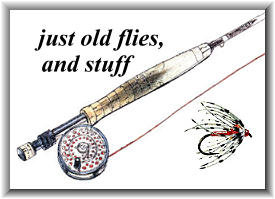This pretty little trout fly originally
had a tail. The Mary Orvis Marbury version,
found in Favorite Flies and Their
Histories, had a tail made from
golden pheasant crest, and the wings were
a bit different as well. She says this about
the early construction of the fly:
"The Hoskins, named after a gentleman
living in western New York, well known as
a successful angler, is a fly greatly depended
upon by those accustomed to using it. The
wings should be hyaline [translucent] and
very slightly mottled; the tail, or stylets,
of genuine golden-pheasant crest, not a dyed
feather; and the hackle a true dun: these,
with the delicate yellow body, make a most
desirable combination, resembling some of
the drakes or Ephemeroptera."
By the time of Ray Bergman's book Trout
in 1938, the fly was simplified a great deal.
The mottled wing, which looks like mallard flank
in Marbury's book, is replaced with light slate
mallard quill, and the tail is gone. There is
no longer a tag on the fly, which can make the
construction a bit dicey. What can happen to
floss bodies with no tag is that the floss can
"drift" back over the rear of the fly when it's
fished or played with at all, especially if the
floss is wound the traditional way, from the front,
backwards, then forwards.
What I did to solve this problem is tie a
length of floss in where the tail would
normally be. I then did an underbody with
another piece of floss, building a taper,
finally winding my floss tied at the tail
forward over the underbody at the very last.
This keeps everything in place.
I think this fly would perform beautifully
as an emerger today, if tied in small sizes.
Its great simplicity proves the effective
fly doesn't have to be complicated. Here's
Ray Bergman's recipe:
The Hoskins:
Body: Yellow floss.
Hackle: Gray.
Wing: Light slate.
~ Eric Austin
Credits: Favorite Flies and Their
Histories by Mary Orvis Marbury; Trout
by Ray Bergman.
|



